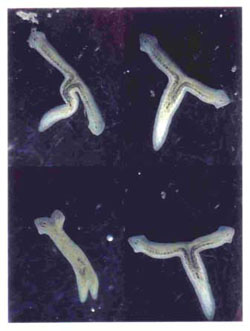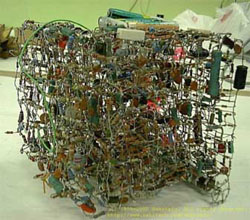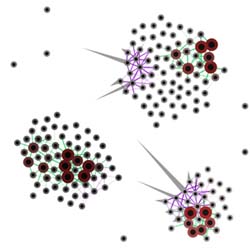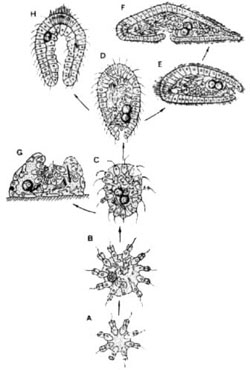|
Description In this exercise, I tried to generate asymmetrical forms from decentralized interaction of cells. A cell, which is a minimum unit of a living organism, does not have a notion of inside and outside, front and back. It is the nature's mystery that those asymmetrical property emerge from simple physical interactions between a number of cells. Based on the background researches, I made a Processing sketch to visualize a simple behavioral system. A user can manipulate and stimulate each cell. Cells get together to make a group, which behaves as if it is one individual organism. If given a centralized system, it is relatively easy to control the group behavior. However, in the nature, an individuality of organism, or at least the appearance of being one individual, emerges from massively pararell interactions of small cells and there is no mechanism of central controlling. To experiment this emergent property, this program deliberately excluded the need for the central contol.
|
|
Background Research |
||
| Asymmetry in Nature | ||
|
Hypothetical stages in the phylogeny of lower Metazoa from Martin Glaessner "Precambrian Research" Vol.20 |
The history of multi cellular organisms goes back as early as 1700 million years ago. The history of living organism is a history of visceral organs [Miki 1989]. Every specie of animals owns visceral organs, which means all of living organisms have morphological inside and outside. In the transition from unicellular organisms to multi cellular organisms, the life acquired the notion of front and back as well as inside and outside. The question how this asymmetrical property emerges in the nature is one of the profound questions which keep arising in many different areas of science such as theoretical physics, mathematics and biology. |
|
| Regeneration | ||
 |
Planaria , or cross-eyed worm, is a common freshwater flatworm. The planarian has very simple organ systems. It has small brain and perceptual organs and digestive system which consists of a mouth, pharynx, and an intestine. However, its morphogenesis is somewhat complicated and mysterious. Planaria has highly robust regeneration system. When its part of body is cut, each piece of the part regenerates itself. In some cases, it gets two heads or two tails. In other cases, it gets two tails. This reproductive behavior of this animal is very interesting in studies of animal morphogenesis. |
|
Regenerative property of Planaria |
||
| Behavior in Artificial Systems | ||
 |
This is a spatial-wired robot made by a japanese engineer. The robot is composed of registers, capacitors and coils. Large potion of this concoctions of RLC circuits is a randomizer, which sends signals to embedded motors to actuate movements. When the robot hits a wall, the wiring gets short-circuit, which changes the random signal sent to the motors to change its behavior. The engineer says, "Even if 70% of the circuit is broken, the robot as a whole still keeps behaving." This robustness comes from the way the robot is constructed: non-centralized controlling. |
|
http://www.nahitech.com/nahitafu/elec/j25.html |
||
 |
References A. Brooks, Rodney A. Cambrian Intelligence |
|
Drawn sketches by SAITO |

